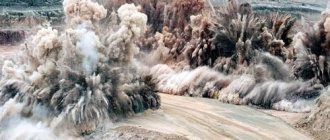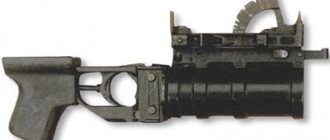What kind of mine did the terrorists want to detonate under Putin's motorcade?
Mine weapons are perhaps the most vile and insidious of what people have created to destroy their own kind. Here you will find booby traps camouflaged as children's toys, and anti-vehicle mines with anti-removal mechanisms. There are magnetic contact mines, as well as anti-aircraft non-contact mines. Improvements in technology have led to the equipping of them with sensitive sensors and radio fuses. First, of course, everything was developed by the military. Well, then, as usual, a lot of things migrated to the civilian sphere, that is, to terrorists.
This is, for example, how the Soviet anti-aircraft mine TM-83 with a charge of a TNT/RDX mixture weighing 9.6 kg operates. The instructions for it say: “... the warhead of the mine is an explosive charge with a recess in which the copper lining is located. During the explosion, a compact striking element of the “shock core” type is formed, moving at a speed of about 3 km/s.” Yeah, and this very core penetrates armor up to 100 mm thick from a distance of 50 m. When a target appears, the mine’s seismic sensor issues a command to turn on the infrared sensor, which registers the thermal radiation of its engine. When it is in the affected area, a command to detonate is issued. Everything is very simple and reliable.
Similar mines are in the armies of France, Great Britain, Sweden, Finland, Bulgaria, Austria, South Africa, the Czech Republic and the USA. Even earlier, in the late 60s - early 70s, anti-aircraft mines appeared (the American M66 and our TM-73, consisting of a launch tube, a rocket-propelled grenade and a fuse sensor, which can be adjusted taking into account the nature of the target. Simplicity, reliability and the secrecy of such devices has contributed to their widespread use by reconnaissance and sabotage groups. Anyone with sufficient funds to pay for the goods and intermediary services can purchase such equipment on the international market. And here is a laser sensor, a microprocessor with protection against reprogramming, and a non-neutralization device and a self-destructor. In a word, high-tech. You can’t fix it on your knees.
Magnetic mines appeared in the late 30s. Very simple - a housing with explosives, equipped with a couple of magnets and a fuse. Any: contact, sentry, chemical, hydrostatic for sea and river mines. The miracle weapon “sticks” to a metal surface. Simplicity contributed to the fact that such mines were made by partisans during the Great Patriotic War. They tore up steam locomotives and gas tanks with them. This simplicity made magnetic mines attractive to killers and terrorists. Remember the murder of St. Petersburg Legislative Assembly deputy Viktor Novoselov in 1999? The killer installed a magnetic mine with a capacity of 300 g of TNT, made in the form of a video cassette and equipped with balls from bearings, on the roof of the victim’s car. Novoselov's head was actually blown off by the explosion.
And what about the recently murdered Iranian nuclear scientist? There, too, a magnetic mine was attached to a car and detonated by a radio signal. The product is so simple that it can be assembled from scrap materials. All you need is a reliable fuse. And anyone with the slightest knowledge of chemistry will make explosives in the kitchen from components purchased at a pharmacy or hardware store.
True, the Unified State Exam has greatly reduced the ranks of self-made Mendeleevs: they don’t know the subject. Judging by what was reported in the press, the terrorists captured in Ukraine were producing acetone triperoxide: it is for this that battery acid, hydroperite and acetone are needed. Triperoxide is a favorite product of half-educated pyrotechnicians: the reaction is very simple and occurs under any conditions and quality of raw materials. She is the one who destroys them. Unwashed hands, a newspaper for drying instead of a blotter (lead in printing ink acts as a catalyst), an attempt to scratch the crystals of the product with a fingernail - an explosion and no good job! However, it is precisely because of this sensitivity that it is not suitable for the main charge. Unless you are planning a volumetric explosion, for which it must be dissolved in ether. But this is no longer a magnetic mine, right? We need to have a more thorough conversation with this Osmaev: where they store dry alcohol and nitric acid, from which they were going to get hexogen. They needed triperoxide as a filling for the detonator...
Story
It was developed in the USSR on the basis of the Soviet OZM-152 mine and put into service in 1973.
The first combat use of the OZM-72 mine occurred during the Afghan War.
On June 7, 1984, during the 1984 Panjshir operation, a tragic incident involving OZM-72 occurred. During the advance to land in helicopters of the reconnaissance company of the 345th Parachute Regiment, when only 1 (one) mine of the OZM-72 type was detonated, 13 soldiers were killed and 14 soldiers were wounded. Among the dead was the company commander, Captain S.V. Belogrudov, and on June 11, 1984, the deputy regiment commander, Lieutenant Colonel S.M. Rodionov, also died from wounds received when this mine was triggered. The mine was planted by sappers of the same regiment during a previous military operation . (According to unverified information, two mines went off).
In the second half of 2000, the border guard of Uzbekistan began installing OZM-72 mines in the border strip near the border with Tajikistan
Wire nets on high stakes
A wire net on high stakes is made of three to five rows of stakes 1.0–1.75 m long, hammered in a checkerboard pattern and braided with barbed wire. The outer rows of stakes are braided with five threads: two diagonally and three horizontally. The inner rows of stakes and the spaces between the rows are braided with three threads: two diagonally and one horizontally from above.
Wire net on high stakes in three rows (19 threads)
It takes 120 man hours to install 100 linear meters of wire mesh on high stakes. Material: single-strand barbed wire – 10 skeins, staples – 25 kg; stakes 175 cm long - 100 pcs.
Set of anti-personnel mining equipment UMP-4
Designed to create a controlled anti-personnel minefield.
KSPPM consists of the following components:
| 1 |
| 4 |
| 2 |
| 2 |
| 2 |
| 2 |
| 1 |
| 10 |
Operation
The controlled minefield is conventionally divided into 4 zones, each 50 m long. Each zone has a non-contact target sensor of a seismic or optical operating principle with a response zone coordinated with the warhead of the OZM-72 anti-personnel fragmentation mine.
The KSPPM kit provides the following functions:
- object detection using non-contact target sensors;
- transmitting signals through executive units to the control panel;
- displaying information about object intrusion on the remote control;
- activation of the corresponding warhead at the operator’s command or autonomously, depending on the selected operating mode (combat-controlled, combat-autonomous, combat-radio-controlled).
The kit allows you to control with display on the front panel of the control panel:
- control line integrity;
- presence of a warhead;
- the fact of connecting remote target sensors;
- current sources in the control panel and in remote target sensors.
The kit can be used as a purely signaling device (without warheads) or in a mixed composition.
Tactical and technical characteristics of the mine
- Type of mine…………………………………….anti-personnel fragmentation fragmentation, ejecting all-round impact.
- Housing…………………………………………..steel.
- Weight………………………..………………………5.0 kg.
- Mass of explosive (MC)………..….660 g.
- Diameter……………………………………..10.8 cm.
- Case height…………………………………17.2 cm.
- Target sensor length (one way)………15m.
- Sensitivity……………………………1 – 17 kg.
- Radius of continuous damage……………………..30m.
- Temperature range of application…..-60 –+60 degrees.
The safety level of a mine installation depends on the type of fuse of the MUV series. For example, when using MUV-2, MUV-3 fuses, from the moment the safety pin is pulled out until the fuse is armed, depending on the ambient temperature, it takes from 3 minutes. (at +40 degrees) up to 59 hours (at -40 degrees).
Mines are packed in boxes of 6 pieces. (gross weight 54 kg) not fully equipped (without MUV fuses and detonator caps No. 8A, with which the mine is equipped at the installation site). However, fuses and detonator caps are placed in a box at the factory.
The mine can also be used with an MVE-72 fuse, which has a target sensor in the form of an inconspicuous thin broken wire. In this case, the combat life of the mine is limited by the shelf life of the “373” type battery.
Option to install a mine in the ground
The figure shows an option for installing a mine in the ground (dimensions are indicated in centimeters). 1- wooden pegs, 2-wire guy, 3-metal peg, 4-double rope with three carabiners, 5-min. When installing a mine, you should keep in mind that if the ground freezes to 10-16 cm, the powder expelling charge will not be able to eject the mine and an explosion will not occur. In anticipation of this, the mine is placed on the ground and tied with mine tape to a metal peg driven into the ground.
2.2. Actions of the squad upon detection of a radio-controlled landmine
- When a sapper (usually equipped with an OSI proximity mine detector) detects a radio-controlled landmine, the command is given: “Move back and take up a perimeter defense.”
- Only one sapper approaches the detected landmine, and with the help of a “Cat” he trawles the area adjacent to the landmine. The actions of a sapper who discovers a radio-controlled land mine are covered by a sapper equipped with an RP-377 jammer.
- The combat guard carries out harassing shelling of the area at possible enemy locations.
- A detected landmine is destroyed on the spot by one sapper overhead charge. It is strictly forbidden to remove (remove) a detected landmine.
2.5. Actions of the squad upon detection of a landmine installed in an uncontrolled version
- When a landmine installed in an uncontrolled version is detected (usually with the help of MRS crews, by a sapper with a mine detector), the sapper informs the group commander with a set signal. The group commander gives the command: “Prepare to repel the attack.” The sapper moves to a safe distance, while marking the boundaries of his verified area on the ground.2.5. Actions of the squad upon detection of a landmine installed in an uncontrolled version.
- The sapper who discovered the contactor carries out additional reconnaissance and the location of the landmine installation. A landmine is destroyed on the spot by an overhead charge. It is strictly forbidden to remove (remove) a detected landmine.
- After destroying the landmine. The area is being inspected. The sappers return to the designated boundaries of the checked areas and continue to carry out the task of reconnaissance of the route.








